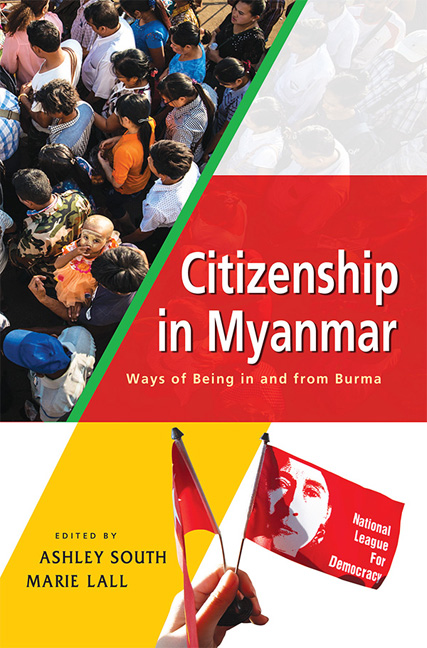Book contents
- Frontmatter
- Dedication
- Contents
- Foreword
- The Contributors
- Map of Myanmar
- Introduction
- 1 Ethnic Politics and Citizenship in History
- 2 Representation and Citizenship in the Future Integration of Ethnic Armed Actors in Myanmar/Burma
- Special Contribution: The Way Forward for Peace, Stability and Progress in Burma/Myanmar
- 3 National Political Dialogue and Practices of Citizenship in Myanmar
- 4 Citizenship and Minority Rights: The Role of “National Race Affairs” Ministers in Myanmar's 2008 Constitution
- Special Contribution: Karenni People at a Glance
- 5 Myanmar's Youth and the Question of Citizenship
- Special Contribution: I Am a Citizen of Myanmar
- 6 “The Value of Life”: Citizenship, Entitlement and Moral Legibility in Provincial Myanmar
- Special Contribution: How I Became Shan
- 7 Conflict and Mass Violence in Arakan (Rakine State): The 1942 Events and Political Identity Formation
- 8 Exploring the Issue of Citizenship in Rakhine State
- Special Contribution: Rohingya and Nationality Status in Myanmar
- 9 Myanmar's Other Muslims: The Case of the Kaman
- Special Contribution: Interview with P'doh Kweh Htoo Win
- Index
Special Contribution: How I Became Shan
Published online by Cambridge University Press: 28 June 2018
- Frontmatter
- Dedication
- Contents
- Foreword
- The Contributors
- Map of Myanmar
- Introduction
- 1 Ethnic Politics and Citizenship in History
- 2 Representation and Citizenship in the Future Integration of Ethnic Armed Actors in Myanmar/Burma
- Special Contribution: The Way Forward for Peace, Stability and Progress in Burma/Myanmar
- 3 National Political Dialogue and Practices of Citizenship in Myanmar
- 4 Citizenship and Minority Rights: The Role of “National Race Affairs” Ministers in Myanmar's 2008 Constitution
- Special Contribution: Karenni People at a Glance
- 5 Myanmar's Youth and the Question of Citizenship
- Special Contribution: I Am a Citizen of Myanmar
- 6 “The Value of Life”: Citizenship, Entitlement and Moral Legibility in Provincial Myanmar
- Special Contribution: How I Became Shan
- 7 Conflict and Mass Violence in Arakan (Rakine State): The 1942 Events and Political Identity Formation
- 8 Exploring the Issue of Citizenship in Rakhine State
- Special Contribution: Rohingya and Nationality Status in Myanmar
- 9 Myanmar's Other Muslims: The Case of the Kaman
- Special Contribution: Interview with P'doh Kweh Htoo Win
- Index
Summary
Yes, I know. These days it is hard to believe I used to be one of the noted Burmese song writers. That I used to speak Burmese more fluently than Shan. That I used to love wearing Burmese longyis than pants.
When I got back to Taunggyi last April to attend a reunion of my extended family, my cousins, nephews and nieces were not only surprised, but also dismayed to find out that I couldn't even remember my own songs. “I remember every song you wrote”, said a cousin, who in fact sang for me when I was asked to sing a song.
It wasn't like that when I moved from Lower Burma back to Shan State in 1954. My father who had participated in demonstrations against feudalist Saofas (Sawbwas) had fled to join the First Shan Rifles, formed after Independence under the leadership of Gen Tin Tut, who had worked with Aung San when he came to Panglong in 1947 to participate in the conference that culminated in the signing of the historic treaty.
I was six years old and spoke Shan only with my grandfather and neighbours. Among us brothers and sisters (actually cousins, as all our parents had left us in the care of our widowed grandfather), who had all been brought up in Burma Proper, the lingua franca among us was Burmese. We all read Burmese novels, sang Burmese songs and dressed like Burmese do.
In 1962, following the coup, we moved to Taunggyi where I was reunited with my parents. My father had left the Burma Army, after he, along with his company, was removed from the Shan Rifles to another unit, and spent years being transferred from one place to another. I was 14 that year and, what's more, I was in love — or thought I was, after reading so many romances written by Burmese authors like Tetkatho Phone Naing, who later became the head of the Taunggyi College, where I attended it in 1966. And like every teenager in love, I was desperately in need of an outlet for my pent-up emotions. And I started to write songs in Burmese. (Took me four years to produce the first song)
All in all, I was on my way to becoming a Burman. Without shame. Or without regret.
- Type
- Chapter
- Information
- Citizenship in MyanmarWays of Being in and from Burma, pp. 188 - 192Publisher: ISEAS–Yusof Ishak InstitutePrint publication year: 2017

